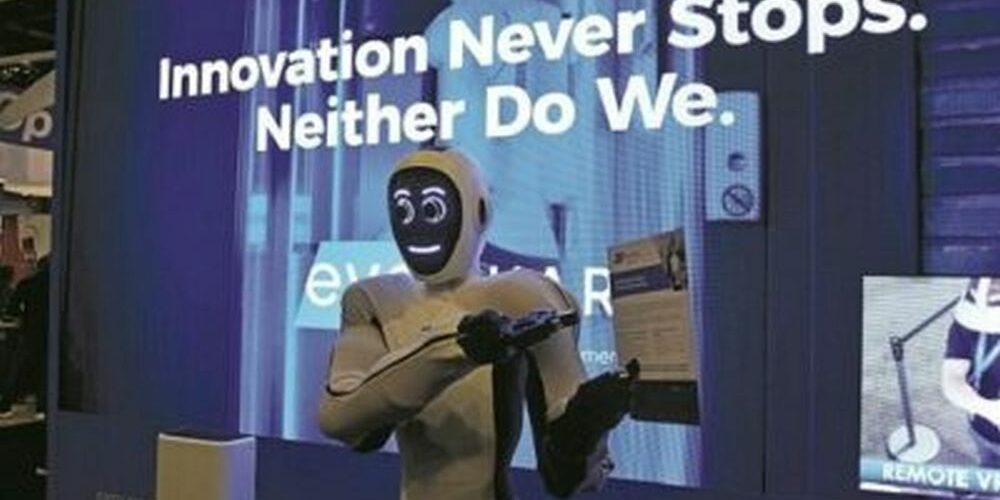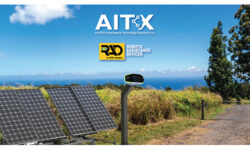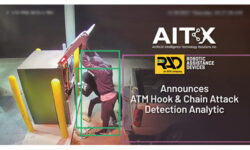ADT Advances Into Autonomous Security Solutions
ADT Commercial robotics and AI experts talk where the technology is today and will be tomorrow, challenges, opportunities, and industry ramifications.

Where it comes to championing and deploying new technologies and services into the electronic security industry, it’s been well evidenced in recent years that ADT is at the leading edge. As the commanding market share leader (reportedly one-fifth of nationwide recurring revenues), the company’s offerings and operations enormously impact the direction and disposition of the entire professional installation and monitoring business. This includes the competitive landscape, investment climate, and public perception of what currently constitutes security and related services.
Thus, when ADT Commercial announced the launch of its EvoGuard intelligent autonomous guarding solutions earlier this year, it likely signified the dawn of a new era of capabilities, possibilities, and opportunities for everyone engaged in the missions of security and safety. The firm has spent the past several years building toward this tipping point moment, acquiring and partnering with leaders in robotics and artificial intelligence. Just a couple months after unveiling its humanoid robot, ADT announced the initial sale of its Tando indoor drones.
“This is exciting stuff,” says Ed Bacco, former head of global corporate and physical security for Amazon and now vice president of emerging technologies for ADT Commercial. “I got to hand it to Dan Bresingham, our executive vice president for commercial who’s making significant investments here. We believe the only way to really drive the industry forward is to lead it. The creation of the EvoGuard is really what we’re focused on with a lot more to come.”
Robotics for the security industry today remains a nascent segment in need of clarity around critical aspects like standards and applications, costs, and technical constraints like range of motion and battery life. But most forward-thinking security practitioners agree AI is the future, and combining its power with machines that can act upon that intelligence, keep people out of harm’s way, and eliminate repetitive, mundane tasks is hard to argue against. Big picture, according to Statista, 2023 U.S. robotics revenue is projected at $7.26 billion with the latest market segment being service robotics.
As further proof that it is “all in,” in late 2022, ADT Commercial appointed its first director of artificial intelligence, Phillippe Sawaya, co-founder of an acquired AI technology startup (Percepta Labs). Today, he is leading ADT’s artificial intelligence team to mobilize purposeful innovation by building the tools to automate and streamline customers’ security programs to encourage adoption of future technologies. SSI spoke with Sawaya and Bacco about the company’s vision for robotics and AI, and what it means for everyone.
Earlier this year, ADT Commercial announced EvoGuard intelligent autonomous guarding solutions. What are the drivers and how did the initiative develop?
Ed Bacco: When I was with Amazon, I spent tens of millions of dollars a year in purchasing guard services. It’s a frustrating business because, while there’s a lot of good people in it, there is a high turnover rate that means you’re always retraining, always starting from bottom. It was unpredictable. We’re looking for a predictable and repeatable process. From a robotics point of view, it was ripe for automation because of the nature of the work, which is mundane. We looked at how we could use technology to change the industry.
We started off by looking at what ADT was selling then, and from my end-user point of view the technology addressed events that had already happened. We had the issue with the guards and then we had this technology that wasn’t helpful telling me about events that were about to happen or might happen in the future. If a burglar alarm system goes off, it means we’re already broken into. If a camera has recorded an event, that event is already gone. It’s in the past.
At ADT Commercial, we knew we needed to help end users make sense of what is currently happening because we’re in this sensor-driven world now, with all this automation. Then, when we get good at that, we can get into predictive analytics about what is going to happen. We started down that path with AI companies like Percepta and Halodi Robotics. We also have a relationship with Indoor Robotics, a drone company.
We are putting these pieces together to start making sense not only about what is happening and helping the end user understand that, but also autonomously gathering intelligence to act upon that data.
Philippe Sawaya: The accelerated pace of these developments in AI and robotics enabled ADT to make this innovative step toward autonomous guarding. When I go to ISC or GSX, I’m astonished by how commonplace a lot of the AI technologies are. Years ago, the state-of-the-art, latest and greatest AI was detecting people and video. Now pretty much every vendor’s camera works as an edge device in the Cloud doing object detection. It’s exciting to see the next generation of solutions with behavioral analytics becoming common.
For ADT, having this confluence of mature technologies at our disposal, these robots, these AI capabilities, has enabled us to push this unified solution forward.
Outside of guarding, in what other ways is ADT actively engaging in robotics or drones or counter drones? What’s the roadmap?
Bacco: We have robotics in the field today. We have the Apollo platform working in a pilot stage. We also have Indoor Robotics with a fully autonomous indoor drone sold and deployed. Among users of our indoor drone is the Movado watch company, which is looking to replace after-hours guards in its facility. The challenge with drones has always been to fly them outdoors, they require FAA certification. That means certified pilots and certified safety observed, so it’s a very cost-prohibitive model.
We’re still a generation away from the point where these technologies can talk to each other, but that’s what’s really needed. We don’t want to just add a bunch of new sensors that then make the job of the end user even more complicated. Our goal is to simplify that, which is why we’re using the AI approach to start interconnecting these systems, so they’re acting in concert with one another. In the future, that’s where we’re headed.

The Tando autonomous indoor drone is part of ADT Commercial’s new EvoGuard brand.
Sawaya: Yes, just adding sensors can overwhelm and increase expense to new systems and hardware. It’s quite interesting that ADT’s position as an integrator means that for most of our customers, we’ve installed not only cameras but burg, access control, building management, temperature controls, all sorts of sensors. There’s an incredible amount of data beyond just the video that is a very hot topic right now. In the future, we may not want to add sensors but rather leverage existing sensors to pull more actionable data from them via machine learning and AI.
It’s really fascinating what you can do when you match up intelligence from a video stream with intelligence from these myriad sensors in a store, and then have the capability to automatically action the results and complete the value chain.
So as of now, drones and robotic guards are not communicating with each other? That’s a couple of years away?
Bacco: Right, they’re not communicating on their own autonomously. That is a couple of years away. We’re approaching all that in a very thoughtful way, being mindful about AI from an ethical standpoint. We’re very aware in today’s environment with all the media around ChatGPT and open AI, which are fantastic tools. ADT positions itself as leading with privacy and ethics in mind in how we design with AI.
We take pride in that because you can take a piece of AI and introduce your own biases from life to it. We spend a great deal of time making sure we’re training all this AI on very diverse datasets. Technically, we could probably connect them all today, but the question is how do we make sure we’re respecting privacy and human dignity in the process?
You mentioned one example, but what are a few other security robotics use cases that are doable right now? What would be some applications?
Bacco: Just like any AI, our humanoid robot out there today, Apollo, will continue to evolve. With any AI, after you roll it out, it has to continue to learn. It’s a toddler today. We will continue to learn and that’s the advantage of this.
Back to the high turnover rate of guards, they spend nine to 12 months learning their job, learning their building, and then they leave. That cycle then starts over with a new person. With the robots, that never happens. They continue to learn their environment. The mechanics might break down, but we’ll just move the memory into a new bot and never lose that. Then, over the next year or two, these bots get smarter and smarter. The bots today are operating autonomously in our building in Dallas. They are patrolling on their own. They are not yet opening doors by themselves autonomously. That will come in the next few months.

One of the objectives of EvoGuard by ADT Commercial is efficiently automating routine tasks, including 24/7 patrols with constant alertness.
That’s the big difference in using a humanoid robot versus a stationary. If you’re going to replace or augment guards, they have to be built and designed to work in the environments that you and I work in, that is in the physical. They have to be able to open doors. They have to be able to present security badges and ride elevators. That is all on the roadmap for the future. That will come very quickly.
The use cases in the future on our roadmap are moving toward a bipedal version that can navigate stairs. Then environmentally they’ll be protected so they can be outside and do the work of almost anything a human guard could do. Remember that most of the guards’ main job is observe and report. The Apollo platform today is always aware of its environment, always sensing it, so the ideal application for these bots is observing and reporting.
Tell me more about ADT’s business model around robotics?
Bacco: In general, our customers don’t want to own a robot. The business model will be robotics as a service because most of the companies already outsource guards because they don’t want to have those guards working for them. That’s not the business they’re in. The model is going to be as a service, either drones as a service, robotics as a service, even be AI as a service because everything’s going to change so quickly. It’s going to constantly change. What the customer cares about is the output. They don’t care about the input.
Sawaya: The model of pricing these things at a pre-analytic basis, similar to the longstanding per-camera approach, makes less and less sense. We’re delivering a service that, under the hood, comprises many different pieces of technology playing together. You can’t sell robotics for guarding without running a bunch of analytics, both on the robot and off of it, without ingesting a lot of other data from other sensors. It’s really a package deal that all coalesces into this single service that’s delivering value, which is what the customer wants.

Among primary features of the Tando autonomous drone is an always-on video feed providing 360˚ surveillance — whether in flight or monitoring from a docking station.
Bacco: That’s the basis of our EvoGuard concept. It’s all of that brought together under one service brand. We want to make it simple for our customers because what they want is to have a guarding service. They want to protect their assets. Most of them have the same challenges we all do right now. COVID really pushed this forward very quickly because there weren’t people at work. It was a challenge and then inflation on top of that. These factors are playing into it. As mentioned, customers just want the output. They don’t need to see how the sausages are made they just want it to work.
I imagine there’ll be menu options for certain functionality or paying at different tiers or something like that?
Bacco: Absolutely, there’d be more and more feature sets, particularly driven by the customers. One of the advantages, why nobody on my team is from the industry, is we’re from the end-user side. We’ve experienced firsthand the pains of the industry and what we needed. We’re solving problems that are close to home for us. We’re also wide awake, aware of the fact that as we put this technology out in the field, customers are going to say, “Hey, what about this and this and this?”
That’s the feedback we want to get from them and be able to offer that back. That’s why having platforms that we don’t need to physically train or change the hardware – which has been the model over and over again in this industry – isn’t OK where if you want something new, rip and replace what you’re doing. We’re trying to build very adaptable pieces of hardware, work with partners to do that, and so the AI, the intelligence behind it, can really change without having to change the hardware.
From the software side of it, what are some practical AI use cases presently and around the corner?
Sawaya: There’s a ton of opportunity in the monitoring world for companies like ADT to make services more efficient. There’s a lot of vendors doing this today at a basic level, for example verifying alarms based on video information. Are there people, or is it just a balloon swinging in the wind that triggered a motion camera? Basic analytics like that are getting more commonplace. There’s a lot of interesting ways to take it a step further that, as an industry, it’s not quite there.

ADT Commercial has been showing off robotics by 1X and delighting attendees at industry trade shows such as GSX, ISC West and CES.
For instance, clueing in on nonvideo information, looking at the natural frequency of when burglar alarms go off and trying to see if there is always an anomaly at 2 a.m. because that’s when the store gets their overnight delivery. It’s incorporating that other genre of information as well as more sophisticated visual analytics to gain an intense behavioral analysis. Loitering isn’t always a problem, but what if we can determine that someone is both loitering and brandished a weapon a minute ago? Or what if we can detect more sophisticated events like glass-breaks and move to just using video as intrusion sensors? There are a lot of interesting possibilities.
It’ll be driven in the next year or two with advances in moving from a fixed point in time to what’s happening in this current viewpoint, what are the objects there, all the way toward looking at broader context across a temporal span of video. What is this person doing now? What did they do before? How can we ascertain what they’re probably likely to do in the future?
Bacco: The false alarm rate for the industry is above 90%. It’s very frustrating and very costly to clear those alarms. For responders, the solution is to either go to every one of those, which is expensive, or start ignoring them, which is also very common. We’re trying to help the monitoring, so the systems would autonomously do that. They’re not doing it today. That is on our roadmap.
Once we start integrating it into the various systems, you could see in the future an alarm coming in through an access control system getting routed directly, without a human involvement, to the closest bot to go validate it using AI to say there is or is not something happening. Maybe it’s that balloon that just went by. The advantage of using the humanoid robot is if the AI hasn’t learned yet what it’s looking at, it’s trained to call home.
The humanoid robot can be operated today as an avatar. If you’re at ADT’s facility in Dallas today, you’d see it being operated autonomously. Then you’d see a human operator taking it over with a set of hand controllers and VR goggles to operate that unit as an avatar of themselves. That means you don’t have to have guards present and clearing alarms to go out to those points. And they can do that remotely from anywhere in the world.
How long will it take for people to become comfortable with robots or widespread deployment of drones to monitor and patrol areas? What of backlash supplanting jobs previously done by humans?
Sawaya: I believe pretty quickly. It’s funny because we all suspect everyone’s scared of the Terminator, everyone’s scared of AI taking over the world or robots and drones going haywire. Every time there’s a big development in robotics, people remark on how fast things are progressing and express fear for the future. But then I think ChatGPT, for example, is a fantastic case study for when these tools and technologies that are so new emerge, and when everyone gets the value that they’re delivering. ChatGPT overnight took over the world.
When everyone gets that these systems are meant for their good, for the public good, especially in our world when it is for their safety and security, once it’s real and tangible acceptance comes pretty quickly.
Bacco: In my career, I predate cellphones and computers. Everybody said nobody’s going to buy cellphones because my first one had something the size of a car battery attached to it. Of course, now we see young children with cellphones because people saw the value and convenience in them. Once that happens with this technology, the same will be true. It’ll be very quickly that they adapt.

Marking the initial EvoGuard brand pilot sale, ADT Commercial recently sold Tando indoor drones to luxury Swiss watchmaker Movado to continue field testing the solution in its distribution center.
As for displacing a workforce, we hear that a lot. But the guarding industry is a good example where it’s very hard to fill those positions. There are more than two million guard jobs in North America. They have tens of thousands of openings. We’re not going to displace those guards, we’re going to fill a void.
With most of the humanoid robot applications, we look for ones where the work is mundane, repetitive and hard to fill. We don’t want to replace all the guards because we need humans to be involved. The type of person who’s going to operate autonomous robotics is still going to be a guard, but they’re going to be a highly trained individual who can operate these systems remotely. That means they’re probably going to be paid higher than a typical guard.
So many security products today tout incorporating AI. As a professional integrator or security dealer, is there any way to tell if they’re just using it as a buzz term or if it’s legitimate AI?
Sawaya: That’s top of mind for us as well because a lot of what we do is testing all those AI solutions. Oftentimes, there’s not much AI going on behind the scenes. It’s a big challenge for everyone to sift through what’s truly using AI and adding value and what’s just capitalizing on the trends. When we go to these conferences and every single vendor claims to have AI. That’s a problem for all of us and something that hopefully as an industry we can iron out.
If you enjoyed this article and want to receive more valuable industry content like this, click here to sign up for our FREE digital newsletters!

Security Is Our Business, Too
For professionals who recommend, buy and install all types of electronic security equipment, a free subscription to Commercial Integrator + Security Sales & Integration is like having a consultant on call. You’ll find an ideal balance of technology and business coverage, with installation tips and techniques for products and updates on how to add to your bottom line.
A FREE subscription to the top resource for security and integration industry will prove to be invaluable.








